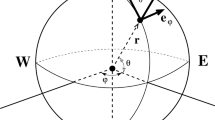Abstract
One-dimensional radiative-convective models are widely used for studying long-term climate and the influence of various processes (condensation of water vapor, motion of droplets, and their impacts on radiative fluxes, etc.) on the hydrodynamics of the atmosphere. However, long-term prediction of climate is difficult due to the properties of the systems of equations, i.e., a small short-wave perturbation of the basic solution leads to a local sharp increase in the amplitude of perturbation. In this work, a one-dimensional nonstationary model with quasi-hydrostatic approximation is established and the short-wave instability is analyzed for various approximate models with the quasi-hydrostatic approximation.
Similar content being viewed by others
REFERENCES
S. Manebe and R. T. Wetherald, ‘‘Thermal equilibrium of the atmosphere with a given distribution of relative humidity,’’ J. Atmos. Sci. 24, 241–259 (1967). https://doi.org/10.1175/1520-0469(1967)024<0241:TEOTAW>2.0.CO;2
T. Augustsson and V. Ramanathan, ‘‘A radiative-convective model study of the CO\({}_{2}\) climate problem,’’ J. Atmos. Sci. 33, 448–451 (1977). https://doi.org/10.1175/1520-0469(1977)034<0448:ARCMSO>2.0.CO;2
V. Ramanathan and J. A. Coakley, Jr., ‘‘Climate modeling through radiative-convective models,’’ Rev. Geophys. 16, 465–489 (1978). https://doi.org/10.1029/RG016i004p00465
T. P. Charlock, ‘‘Cloud optical feedback and climate stability in a radiative-convective model,’’ Tellus 34, 245–254 (1982). https://doi.org/10.1111/j.2153-3490.1982.tb01813.x
K.-N. Liou and S.-C. Ou, ‘‘The role of cloud microphysical processes in climate: An assessment from a one-dimensional perspective,’’ J. Geophys. Res.: Atmos. 94, 8599–8607 (1989). https://doi.org/10.1029/JD094iD06p08599
N. O. Rennó, K. A. Emanuel, and P. H. Stone, ‘‘Radiative-convective model with an explicit hydrologic cycle: 1. Formulation and sensitivity to model parameters,’’ J. Geophys. Res.: Atmos. 99, 14429–14441 (1994). https://doi.org/10.1029/94JD00020
N. O. Rennó, P. H. Stone, and K. A. Emanuel, ‘‘Radiative-convective model with an explicit hydrologic cycle: 2. Sensitivity to large changes in solar forcing,’’ J. Geophys. Res.: Atmos. 99, 17001–17020 (1944). https://doi.org/10.1029/94JD01332
M. A. Kelly, D. A. Randall, and G. L. Stephens, ‘‘A simple radiative-convective model with a hydrological cycle and interactive clouds,’’ Q. J. Roy. Meteorol. Soc. 125 (555), 837–869 (1999). https://doi.org/10.1002/qj.49712555505
V. E. Larson, ‘‘Stability properties of and scaling laws for a dry radiative-convective atmosphere,’’ Q. J. Roy. Meteorol. Soc. 126 (562), 145–171 (2000). https://doi.org/10.1002/qj.49712656208
V. E. Larson, ‘‘The effects of thermal radiation on dry convective instability,’’ Dyn. Atmos. Oceans 34, 45–71 (2001). https://doi.org/10.1016/S0377-0265(01)00060-4
K. Emanuel, A. A. Wing, and E. M. Vincent, ‘‘Radiative-convective instability,’’ J. Adv. Model. Earth Syst. 6, 75–90 (2014). https://doi.org/10.1002/2013MS000270
Z. Fuchs and D. J. Raymond, ‘‘Large-scale modes in a rotating atmosphere with radiative-convective instability and WISHE,’’ J. Atmos. Sci. 62, 4084–4094 (2005). https://doi.org/10.1175/JAS3582.1
T. Beucler, T. Cronin, and K. Emanuel, ‘‘A linear response framework for radiative-convective instability,’’ J. Adv. Model. Earth Syst. 10, 1924–1951 (2018). https://doi.org/10.1029/2018MS001280
R. I. Nigmatulin, ‘‘Equations of hydro- and thermodynamics of the atmosphere when inertial forces are small in comparison with gravity,’’ Fluid Dyn. 53, S121–S130 (2018). https://doi.org/10.1134/S0015462818040201
A. S. Monin, Theoretical Foundations of Geophysical Fluid Dynamics (Gidrometeoizdat, Moscow, 1988).
L. D. Landau and E. M. Lifshits, Theoretical Physics, vol. 6: Fluid Dynamics (Nauka, Moscow, 1986).
J. R. Holton and G. J. Hakim, An Introduction to Dynamic Meteorology, 5th ed. (Academic Press, Waltham, 2012).
G. I. Marchuk, Numerical Solution to Problems of Atmospheric and Oceanic Dynamics (Gidrometeoizdat, Moscow, 1974).
Funding
The work is supported by the Chinese Scholarship Council, project no. 201306840046.
Author information
Authors and Affiliations
Corresponding author
Additional information
Translated by E. Oborin
About this article
Cite this article
Xu, X. On Short-Wave Instability of One-Dimensional Radiative-Convective Models of Atmosphere in Quasi-Hydrostatic Approximation. Moscow Univ. Mech. Bull. 76, 105–110 (2021). https://doi.org/10.3103/S002713302104004X
Received:
Revised:
Accepted:
Published:
Issue Date:
DOI: https://doi.org/10.3103/S002713302104004X



